
The Book Review
HIKING NAKED
A Quaker Woman's Search for Balance
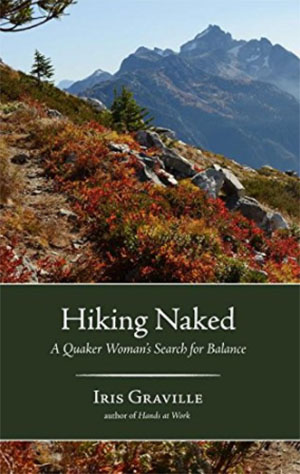
“Hiking Naked is a compelling examination of the intention to serve
those around us—and the search for God’s voice in the wilderness of civilization.”
By Ellen Michaud
Discernment has got to be the toughest process in which Quakers engage.
It is deep, it is profound, and it is often frustrating as we circle round and round a particular question, a particular issue, a particular set of circumstances. But the sense of rightness, and the experience of patient, everlasting, and overwhelming love as we come to finally understand that we are led in one direction or another touches our souls, grows our faith, and teaches us both patient waiting and trust. And it opens us to time on a millennial scale, not a human one.
But what happens when the process goes on for years in relation to a single, pivotal leading such as a career choice? What happens when, on some level, you sense that a leading has either disappeared or morphed into something else that you can’t seem to recognize? Can’t seem to find? Can’t even define?
Those are the questions at the heart of Hiking Naked: A Quaker Woman’s Search for Balance—a riveting and lyrical memoir by award-winning author Iris Graville.
Iris had been led to a nursing career early in life, and had pursued that leading through direct service, administrative, and policy-making roles in public health for close to 20 years. Eventually, the overwhelming needs of patients with few resources, and the demands of an overwhelmed and under-staffed health care system triggered major burnout. She wondered if she was really making a difference in her patients’ lives—and if the demands of her work were worth what she was able to achieve.
But none of the usual strategies for burnout like switching jobs, attending meeting, or a week’s vacation in the country seemed to help. Eventually, driven by an urgency she could barely define, Iris quit her job, left her desk stacked high with urgent messages, and convinced her husband and 10 year-old twins to leave their home and spend two years deep in the wilderness of Stehekin, a remote mountain village of 85 neighborly people in Washington State’s North Cascades. It was a place stripped down to the essentials. There was only one phone in the village, no highway, no grocery store, no doctor, just pine, fir, rock, bears, floods, ice, snow, raging rivers, forest fires, a lake 50-some miles long, and ordering groceries by mail---to be delivered by boat once a week.
The change was radical. But, as Iris details in her book, after two years of solitary walks, thought, questions, work, journaling, reading, and figuring out how to get slush out of the washing machine, she was finally able to hear the whispers of God.
Helped immeasurably by Iris’ keen eye for detail in the wilderness in which she lived, her sensitivity to the feelings, needs and nuances of those she met, and her openness to sharing the questions and doubts she experienced about what God was calling her to do, Hiking Naked is a compelling examination of the intention to serve those around us— and the search for God’s voice in the wilderness of civilization.
Although graced with what is probably the most riveting book title in recent memory, and although it’s true that her husband, on one hot day, did hike naked up a mountain trail in an isolated region of the Cascades just to make his mentally exhausted wife laugh, the title is actually a metaphor for striping life of all but the essentials, then examining it piece by piece, learning the lessons that—to the ear that hears, the eye that sees, the heart that beats with love—allows us to breathe in the whispers of God and follow where they lead.
©2017 Ellen Michaud
OUR LIFE IS LOVE
The Quaker Spiritual Journey
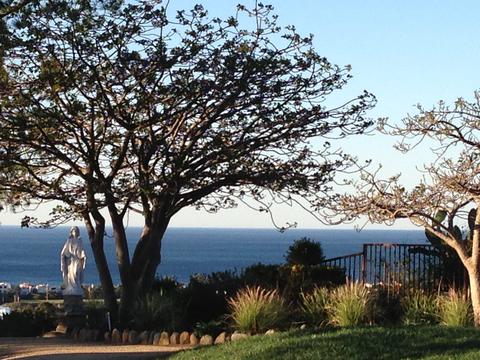
“Our Life is Love will help each of us recognize who we are as a
people, where we’ve been, where we are, and—as Way opens—where
we’re being led.”
By Ellen Michaud
The winds blowing in off the Pacific Ocean at Serra Point were wild. Hummingbirds, their feathers gleaming in the morning light, made short hops from flowering shrubs to nests high in the surrounding trees. Tiny lizards ran belly-to-the-ground from rock to rock. Thirty-foot box elders waved their branches, and the sun, which was directly overhead, baked the sandy path on which I stood, eyes half closed, totally relaxed, and deeply centered.
I’d come here to a Franciscan retreat center in the hills above Malibu for a few days of quiet contemplation, and to read the manuscript of a new book by Marcelle Martin, a former teacher of Quaker Studies at Pendle Hill.
I’d met Marcelle some 16 or 17 years ago when we’d both participated in the School of the Spirit’s program on Contemplative Living and Prayer. Our lives had touched here and there over the years, and I knew Marcelle had felt led to write a book for some time.
Now, here it was, in my hands.
Smiling, I sat down on a bench tucked away from the wind and began to read Our Life is Love: The Quaker Spiritual Journey.
The book takes its title, I quickly discovered, from Isaac Penington’s simple but eloquent description of Quaker life in 1667:
Our life is love, and peace, and tenderness; and bearing one with another, and forgiving one another, and not laying accusations one against another; but praying one for another, and helping one another up with a tender hand…[until that love and peace and tenderness is reflected] in the eyes of all with whom ye converse.
For early Quakers, Marcelle writes, the life Penington describes was a reflection of the radical transformation that began from the moment an individual felt the first stirrings of a longing to know God. Among contemporary Quakers, she adds, that longing is just as compelling today, although for some it’s identified simply as a longing for spiritual truth, or even simply as a “…dissatisfaction with the ways of the world and a vague sense that we are meant to live in a better way.”
But after studying the lives of early Quakers and traveling among Friends today, Marcelle has come to understand that, however that first step is characterized, the Quaker spiritual journey to a life of profound love travels along a well-trod path of awakening, convincement, and faithfulness that is identified by 10 hallmarks that she describes, chapter by chapter. They include:
• A longing for God or spiritual truth.
• The earnest seeking of a deeper spiritual life—sometimes through social action, other times through an exploration of nature, or through the exploration of deeper experiences within a current religious tradition.
• The impulse to turn within—with the expectation of encountering God’s Presence.
• The experience of an “opening,” or a revelation of truth directly from God—sometimes found in the “… profound experience of divine Love or Presence…[or] sometimes in the courageous strength to speak or act in faithful or prophetic ways…[and sometimes] as a quietly growing conviction about how God wants one to believe, speak, and act…”
• A willingness to be changed by the “refiner’s fire”—to stand in the Light and clearly see all the hurts, angers, fears, and ego-centered needs that give birth to the ambitions, expectations and actions that can stand between us and God. To strip them away and emerge, transformed, as an individual who lives in God’s love and shares it freely.
• The collective experience of God’s Presence in a Quaker community, frequently during meeting for worship, often with an awareness of being gathered into a single body, and often with a sense among those newly attending that they have come home.
• A sense of God’s love and the gentle but persistent tugs, or “leadings,” of the Spirit in one direction or another to specific actions.
• The willingness to, as 17th century Quakers termed it, “live in the cross,” a concept that today means, as Marcelle suggests, a willingness to follow leadings that can involving suffering, such as those experienced by civil rights activist Bayard Rustin, who was jailed and beaten, or Christian Peacemaker Team member Tom Fox, who was killed in Iraq.
• Abiding—a state in which we live in the Presence even as we talk with friends or tend to the 101 chores of daily life.
• The achievement of “perfection,” which refers to the sense of wholeness that we experience when, as Marcelle writes, “…God becomes the active force in a person’s life and any goal other than loving faithfulness has fallen away.”
Using these hallmarks to structure Our Life is Love is an effective way to look at a complex subject whose very nature demands simplicity. Equally helpful is the fact that the book is written in measured tones, with great clarity, and with story after story of both early and contemporary Quakers—an approach that allows Marcelle to extricate the spiritual elements of our common Quaker journey from the complexity of our schisms and the heartbreaking divisions that run throughout our history.
The brief but well-crafted stories of 33 early Quakers like Elizabeth Hooten and James Naylor evoke powerful, piercing images that offer concrete examples of spiritual journeys from which to extract valuable lessons, as do the 62 stories of more contemporary Quakers such as Richard Taylor, Eva Hermann, and Thomas Kelly.
What also makes Our Life Is Love far more accessible than many books on Quaker spirituality is that Marcelle does not write, as Carole Spencer, an associate professor at Earlham School of Religion, points out in the book’s foreword, “…as a detached historian, analytical theologian, or objective outside observer, but as an intuitive, empathetic fellow traveler [who] shares their spiritual DNA. She enters into their story with empathy, thus parting the veil for the modern reader to cross the threshold into the profound realm of [even] those early Quakers who lived a life of holiness and perfection.”
As a result, and particularly if one or another of its chapters is read in the meeting community and accompanied by reflection and discussion, Our Life is Love will help each of us recognize who we are as a people, where we’ve been, where we are, and—as Way opens—where we’re being led.
It’s an amazing journey. And we are so blessed to be on it.
©2016 Ellen Michaud
FIRST DAY STORIES
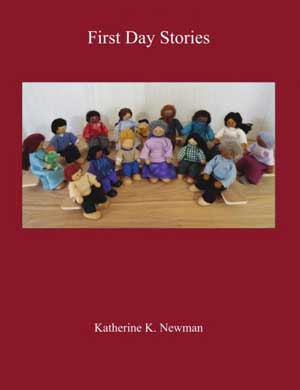
"In First Day Stories, both First Day School teachers and parents have
been given a tool with which to encourage the wondering that propels children into the very heart of God."
By Ellen Michaud
The light voices of seven small, happy children drifted among the early spring flowers and through the windows of Redwood Forest Friends Meeting in Santa Rosa. Waving the paper projects they’d made this morning in First Day School, the children were walking along the graveled path from their schoolroom to join adult Friends in the final minutes of unprogrammed worship.
A moment later, the Meetinghouse door opened, and the children quietly spilled through the entrance—bashfully sliding into chairs beside the door or joyfully making a dash to their parents and climbing into their laps.
Except for the occasional twitch of lips into small, secret smiles, Friends remained centered, most with closed eyes. The children studied the faces around them curiously, then studied their paper projects, then looked up again at those around them—eyes moving from one adult Friend to another. Their curiosity was palpable as observant eyes shifted from Friend to Friend and their agile little minds absorbed, questioned, and wondered.
Their curiosity and wonder brought tears to my eyes. Because that wonder, and all those wonderful questions to which it gives birth, are what open children to the presence of God in both meeting and their lives.
As a young mother and First Day School teacher, I often worried about how to communicate to young children the incredible experience of sitting down in meeting, centering in the Presence, and joyously opening to it. Yes, that which is God will, in one way or another, reach out to our children. But when the children hear so many in our culture so often deny God’s very existence—and when we Friends are often so reticent about expressing or even naming our own experiences of God—well, I admit that I worried.
Now there is no need. Because with the publication of Katherine K. Newman’s First Day Stories, both First Day School teachers and parents have been given a tool with which to encourage the wondering that propels children into the very heart of God.
Written for children from 3 to 6, First Day Stories includes 12 stories centered around family life, the shared experience of an unprogramfmed Friends meeting, and the practices that evidence our faith. Through the eyes of one little boy, one little girl, and the grandparents with whom they live, for example, readers explore simplicity as the children and their grandparents consider whether or not they should get a third pet. They explore peace as it focuses on the little girl’s anger at a friend. And a third story focuses on building community.
In that story, the little girl approaches an elderly gentleman to shake hands after meeting. He doesn’t respond. So after subsequent meetings, the little girl makes no effort to shake hands. When her grandmother asks why she’s ignoring him, the girl explains. The grandmother tells her granddaughter that the elderly gentleman doesn’t see or hear well—and that he might not have realized that the little girl was greeting him. He also might not have been able to see the hand she extended.
After meeting the following week, the little girl goes over to the man and touches his arm to get his attention. He immediately extends his hand, and greets her in a loud voice. “Good Morning! Good morning! Who are you and how are you?” The girl responds and their after-meeting conversations become a weekly experience.
First Day Stories is, I suspect, unique in Quaker children’s literature. It opens our children to thinking about what’s taking place in meeting and to the reasons behind many of our practices like holding someone in the Light. It belongs in every child’s First Day School—and in every home.
Its author, Katherine K. Newman, a member of Sacramento Friends Meeting, has taught at both the University of Houston and Sacramento State University, and spent 15 years developing elementary school curricula in reading, spelling and writing. She has also been a First Day School teacher for over 35 years.
©2017 Ellen Michaud
LE FLAMBEAU SCHOOL OF DRIVING
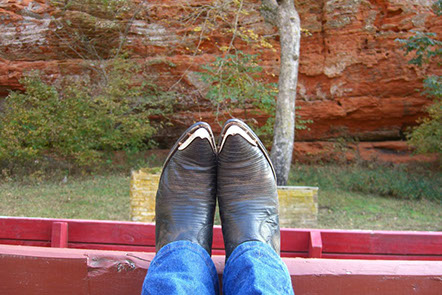
"And then their is Peggy—God's very own loose cannon."
By Ellen Michaud
One moment with Peggy Senger Morrison—Quaker pastor, author, therapist, motorcycle enthusiast, mother, grandmother and founder of Oregon’s Freedom Friends’ Church—and the myth among non-Friends that Quaker women are quiet, gentle little creatures who go quietly into the night will be shattered forever.
I don’t know how the myth got started, particularly since quite a few of our historical sisters harangued people in the streets and most of the women I know today are up to their elbows in social issues with Magic-markers, email, demonstrations, T-shirts, and letters-to-the-editor.
But once Peggy Senger Morrison roars by on her 300-pound motorcycle or stands in front of a crowd in boots and leathers and begins to preach, I’ve no doubt our reputations will be framed more accurately.
Fortunately, for those who will not be privileged to experience Peggy in person, it will also be framed more accurately by settling down with one of her books—as I discovered when I opened her latest, Le Flambeau School of Driving.
I had just moved cross-country from Vermont to California and was so battered by movers’ estimates, packing lists, inventories, boxes bigger than I was, and the California DMV—which refused to accept my Vermont photo driver’s license and marriage certificate as proof I am who I say I am—that I could hardly move. So when Le Flambeau arrived on my doorstep, I dropped my boxcutter, brewed a cup of tea, and settled on my little jasmine-framed porch to escape the chaos.
An hour later, the tea had grown cold, the sun had snuck under the eves to burn my thighs, and I was too riveted by Peggy’s words to move.
The woman is a gift.
Le Flambeau—literally, the “burning torch”—is a book of 100+ narrative essays and first-person stories that clearly show how one woman burning with the Light within is led and schooled as she ignites, sees what many of us miss, and moves through life touching every person she meets.
The essays, some of which have appeared in earlier work, cover a wide variety of topics from spiritual disciplines for the 21st century to illuminating discussions of Quaker “proselyphobia,” noisy Quakers, and climate change theology. Some essays are short blurts of truth that Peggy has uncovered as she motors through life; others are longer weaves of Quaker thought and history combined with an understanding of human frailty and strength.
Each essay is grounded in a personal story, a sense of Presence, a deep understanding of human nature, a no-holds-barred personal honesty, and a big helping of Peggy’s insight and killer humor.
Her story-telling abilities are particularly sharp in a riveting and detailed 73-page section of individual stories based on her hair-raising adventures as a trauma healer in Africa. Buses in Kigali that drop off cliffs, toilets of slippery poles that must be negotiated with the balance of a tightrope walker over a pit in Congo, and driving in Burundi add the kind of on-the-ground detail that allows us a glimpse of the beautiful human beings in Africa Peggy meets—and whom we never seem to hear about on the nightly news.
But it is particularly in her stories of churches and meetings both in Africa and here in the United States that Peggy shows us who we, as Friends, can be.
“The meeting I usually attend is a Quaker hybrid,” writes Peggy. “We sing a little. We pray out loud a bit. Then we settle down and shut up. Someone usually receives a message to speak, often several someones. The messages are usually right on target. We like the peace that we get between the messages. Most of the people in the room are new Quakers; they are acquiring a taste for the silence.”
One day, a man, accompanied by a little boy who seemed to have some degree of autism walked in. The boy, Peggy says, immediately and loudly said, “Oh no! Not Church! Don’t want church!” And when Peggy greeted the two, the father confessed his fear that attending a church wouldn’t work and they might not be able to stay. Peggy urged him to try, and the man and his son sat down.
For the next hour, the boy yipped, muttered, exclaimed and moaned. And in the midst of his offering, other vocal ministry rose from those gathered.
“We sang,” writes Peggy ““We prayed…“We settled into silence. The boy moaned, clucked, muttered, and talked…[then] other vocal ministry aroset was sweet. It was true. It was just what Jesus would have said. It didn’t directly address the situation; it addressed the needs of the meeting.”
The result?,
“I experienced what some Quakers call “gathering,”writes Peggy. “It is a deepening of the silence. A kind of mystical feeling of the bottom dropping out of the meeting. A transcendence; a visceral experience of the presence of God”
When the meeting rose, Friends greeted father and son, and the father tried to apologize for his son’s behavior. Friends wouldn’t have anything to do with the apology, Peggy writes. “The purpose of meeting is not to escape from the world to a place quiet enough to listen, but to learn to listen well enough that we can listen anywhere, under any conditions. It had been a good meeting and rewarding morning’s practicum. We were grateful.”
Le Flambeau also includes a brief foreword by Quaker author William Ashforth.. It skips lightly through our schisms to deliver an abbreviated overview of the four main branches of Quakerism in the United States today, then concludes with Ashforth’s comment, “And then there is Peggy…God’s very own loose cannon.”
Clearly the man knows her.
©2016 Ellen Michaud
A LANGUAGE FOR THE INWARD LANDSCAPE
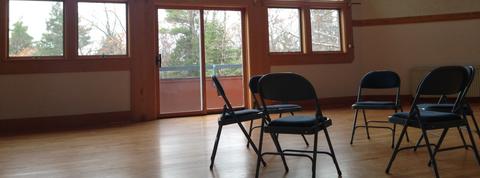
"...as a result of the collaboration between these two deeply faithful men, to read A Language for the Inward Landscape is to often be touched by a sense of recognition, an awareness of God’s presence, and an upwelling of love so large and deep and expansive that it is not unlike sitting in a gathered meeting within a beloved meeting community."
By Ellen Michaud
As I walked up the path to a friend’s home here in Vermont, snowdrops lightly iced with spring snow bordered my journey. Bees covered the delicate flowers, a sleepy cat dozed in the window, and a huge pot of boiling maple syrup beside the door sent clouds of sweetly-scented steam up into the sunshine.
It was a small moment, but one which filled me with joy. I was meeting with a small group of Friends in the area to discuss our spiritual growth. It was something that we do once a year, and as we greeted one another and gathered around the woodstove, the love among us and the joy we took in one another’s company was palpable.
Gradually we settled into silence. Wood crackled in the woodstove and the sense of Presence grew deep. Our clerk posed a question, and, eventually, I felt led to say that, over the past year, I had felt a growing sense of Presence in our meetings, and that I had been truly humbled to have experienced a gathered meeting on more than one occasion—something that had been a rarity among our group.
My words dropped into the silence. And as it deepened, a woman who had worshiped with us for more than a decade leaned forward, looked at me directly, and asked, “What’s a `gathered’ meeting?”
Startled, I looked at her for a moment, then at the others sitting around the fire. They looked back at me steadily, understanding that it wasn’t a rhetorical question, and trusting that the answer I’d offer would rise out of the silence. And it did. But, later, as I drove home along the muddy spring roads thinking about what had occurred, I realized that the simple question had left me with a deep sense of sadness.
How was it that one of our beloved community could sit with us for so many years and not know the definition of a gathered meeting? How could a Friend whom I know to be deeply centered in the Presence—whose life richly evidences every testimony Quakers hold dear—how could she not know the words that would allow her to discuss her experience of being held as one in the Presence?
Could it be that those of us in our meeting had failed her? We rarely talk about what actually occurs during meeting for worship, I realized. We tend to leave much of that job to the Inward Teacher. But, also, I had to admit, because we’re afraid of not being inclusive or of causing dissension.
As I got out of the car, the sense of conviction was heavy. Was it possible that our fears had caused us to deny this wonderfully faithful woman a vocabulary with which to explore her own inward landscape? And how could we rectify the situation? How could we encourage a discussion of what we experience during meeting for worship?
Days later, a copy of Brian Drayton’s new book, A Language for the Inward Landscape: Spiritual Wisdom from the Quaker Movement arrived on my doorstep to review for this blog.
To say that it was welcome is an understatement. Brian, a recorded minister in New England Yearly Meeting and author of On Living with a Concern for Gospel Ministry (QuakerPress, 2005), has spent a lifetime reading and studying early Quaker manuscripts. Now, in A Language for the Inward Landscape, he has used that study to decode many of the words that have evolved over time to give Friends a kind of spiritual shorthand in which a simple word reflects a deep, complex experience of life lived in the Presence.
He begins with a chapter on the “foundational” terms of wait, life, and light, all of which, as Brian writes, “…express something of the dynamic reality at the center of Quaker practice…”, then continues with 64 additional words and phrases that capture the essence of the Quaker experience.
Yet what Brian offers is not simply a vocabulary list with brief, knee-jerk definitions. Oh, the list is there, all right. But with each entry on that list are short, thoughtful essays, which, informed by Brian’s steadfast scholarship, ground us in how these terms were used by early Quakers, and allow us to follow the evolution of their words, along with their faith, through the past three centuries and in to the present.
“Light,” for example, originally referred to the way in which early Quakers encountered Christ among them. As Brian quotes Isaac Penington:
Q: But hath not this Saviour a name? What is his name?
A: It were better for thee to learn his name by feeling his virtue and power in thy heart, than by rote. Yet, if thou canst receive it, this is his name, the Light; the Light of the World…we call him light, because the Father of lights have peculiarly chosen this name for him, to make him known to his people in this age by, and hath thus made him manifest to us. And by thus receiving him under this name, we come to know his other names.”
Today, the Light is still understood throughout much of the world to be the Light of Christ. But over the years, we have indeed “come to know his other names,” and, for some Friends, to no longer need names at all. As Brian writes,
Sometimes the word light serves as a way to speak of the Divine in a tone that feels intimate, in the way that seeing is intimate: a very personal interaction with a Reality, which does not require us to put names on the experience, nor give an account in words…
Brian’s vocabulary list and many of his essays are rooted in the work of the late Bill Taber, a gifted Quaker minister, workshop leader, and Pendle Hill teacher whom Brian credits as the co-author of A Language for the Inward Landscape. During his life, Bill led workshops and retreats from which he left behind over 150 pages of notes, memos, file cards, and outlines, plus one complete lecture manuscript labeled “John Woolman’s language of the inward landscape. ”
The papers were a rich legacy. Fran Taber, Bill’s wife and a gifted teacher in her own right, shared them with Brian, who used the outline from Bill’s last workshop to build the book’s structure. He and Bill had spoken long and often about the inward landscape, and, in some sense, the book seems to have become an extension of the dialogue between them.
Now, as a result of the collaboration between these two deeply faithful men, to read A Language for the Inward Landscape is to often be touched by a sense of recognition, an awareness of God’s presence, and an upwelling of love so large and deep and expansive that it is not unlike sitting in a gathered meeting within a beloved meeting community.
We are so blessed.
©2016 Ellen Michaud
HOLY NATION
The Transatlantic Quaker Ministry in an Age of Revolution
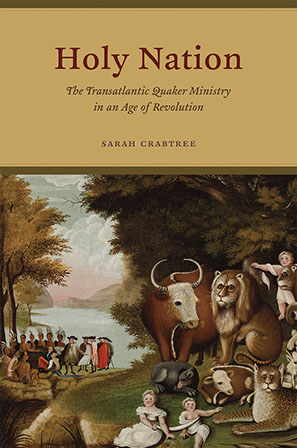
"Sarah Crabtree’s new book Holy Nation: The Transatlantic Quaker
Ministry in an Age of Revolution is a gift that allows Quakers to see
with fresh eyes what we do, how we’re perceived, and who we are."
By Ellen Michaud
Tossing Sarah Crabtree’s Holy Nation: The Transatlantic Quaker Ministry in an Age of Revolution on top of the pile of books strewn across my cottage’s dining room table, I picked up my coffee, leaned back in my chair, and wondered where on earth this author had come from.
The clarity of her writing was exceptional. Her intuitive understanding of when to shift the reader into a new space before he or she could get bored or tangled in historical minutia remarkable, and the book read like a fast-paced detective novel. But on every single page, I had filled the margins with questions, exclamation points, arguments, asterisks, and my own special notation system for what-the-heck?
I looked out the window into the forest, watched the light of a summer sun dancing through tall pines, and thought about what I’d been reading.
Until I’d picked up Sarah’s book, I had been packing up my “library”—about 400 books that lined the shelves of my dining room—in preparation for a move to California. Most of the books I was giving away. But the 100 or so books on Quaker faith and practice, memoir, history, sufferings, and Friends’ testimonies—plus several of Phil Gulley’s novels and a copy of A Quaker Woman’s Cookbook with Elizabeth Ellicott Lea’s 1845 thoughts on “domestic cookery”— all those books that I had particularly treasured through the years were on the table under Sarah’s book, ready to be packed.
Holy Nation by Sarah CrabtreeRandomly looking through the pile as I sipped my coffee, I puzzled over just how Sarah’s book was different from the rest, particularly the histories. It took awhile, but I finally realized that, drawn from nearly 10 years of scholarship within the Quaker collections at Swarthmore, Haverford, and Westtown, plus various historical collections both here and abroad, Sarah’s combination of research, thought, clarity and sheer writing ability had allowed me to see how others—particularly those who are not part of a Quaker community—may view Friends’ actions in the past, the present, and into the future. And although, as she writes, she did not intend her book to serve Friends directly, it is actually a gift that allows us to see what we do, how we’re perceived, and who we are with fresh eyes.
Focusing on the tumultuous years between 1754 and 1826, the questions she addresses within its pages are complex. Did the peace testimony evolve as an extension of our early Christian heritage? Or was it simply a politically expedient solution to the increasing anger among those in Britain who saw our deep beliefs and passionate activities as a threat to their own power?
Did Friends’ schools evolve out of a commitment to change the world? Did they come into existence to offer an alternative way of being in a violent, war-prone society? Or did they develop to proselytize and strengthen the foundations of the Religious Society of Friends?And what about our social activism? Was our collaboration with “benevolent organizations” to effect social change after the American Revolution simply a post-revolutionary defensive ploy to smooth over conflicts with those in power who felt threatened by our lack of nationalism? Or was it a practical attempt to build an infrastructure that would allow others with a more acceptable public posture to move forward the social reforms to which we felt led?
These are fascinating questions. But although I appreciate the fact that Sarah’s work allows us to look at our past in fresh ways, that doesn’t mean that I think she’s right in some of the conclusions she draws from her scholarship.
For one thing, there’s very little acknowledgement in her book that Quakes are led in one direction or another by the Light, nor even an indication that she understands what following a leading entails. Instead, she often seems to attribute our efforts to create a more loving world to the notion that we’re doing it simply to make sure that we, as an organized religion—“a holy nation”—survive.
As you might suspect, that last postulation met with several pungent comments written into the margins of her book. Yet Sarah’s straightforward questions have allowed me to see us as others might. They have allowed me the grace of understanding why others perceive us as they do, and caused me to examine our actions over the centuries with new eyes, question those same actions myself, and see how the answers I discover might influence actions I take as a Quaker today and into the future.
A Holy Nation is highly recommended for book discussion groups that are not afraid to light a fire under their participants and have them re-examine who they are and where they’re going—both individually and as members of the Religious Society of Friends.
The book is pricey—around $45—so meetings may want to buy a few copies that can be shared among their members.
©2016 Ellen Michaud


